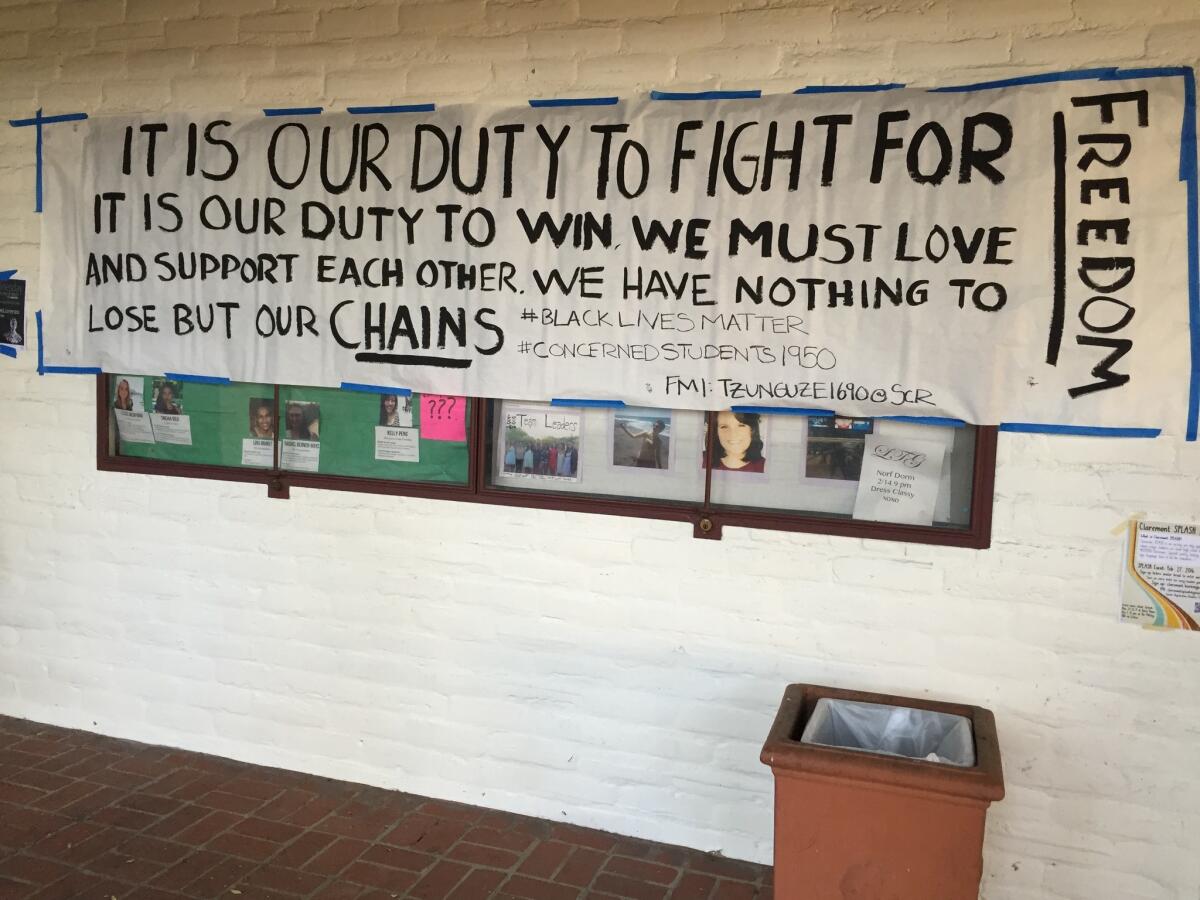Column: At Claremont McKenna: Seeking a sweet spot between anger and forgiveness
On a spectacular afternoon this week, a junior named Nathaniel Tsai and I sat a rooftop deck at Claremont McKenna College. The leaves were turning, the San Gabriels had a light dusting of snow. There was hardly any sign that this idyllic place had become another outpost in the struggle for racial equality that’s been roiling college campuses across the country.
Lately, there have been marches, shouting matches, Facebook arguments, open letters cataloging “microaggressions” both in the classroom and out, secret summits, righteous indignation and many unaccepted apologies.
Since early this year, activists who identify themselves as “students of institutionally marginalized communities” have been asking the college for a resource center. Such students--minorities, LBGT--have felt “intimidated,” “excluded,” “isolated” and “scared,” according to an open letter they circulated this fall. The school’s failure to act, and what the students see as the administration’s fruitless promises, set the stage for the recent eruptions.
As it turns out, not everyone is on board with the tactics of the revolution.
On Saturday, Tsai, 19, composed his own open letter, taking issue with some of the protesters’ behavior.
“Keep in mind we are not your opposition, we do not fight against what you are trying to accomplish, nor do we seek to discredit you,” wrote Tsai, who is of Chinese Filipino descent.
Nonetheless, he wrote, marching students who shouted profanities while news cameras were rolling had damaged the school’s reputation. A hunger strike in response to an insensitive phrase by Mary Spellman, a dean of students, was “extremely inappropriate.” (Spellman, who is white, had written that the college was trying to do better by students “who do not fit our CMC mold.” She resigned, thus bringing an end to the hunger strike after two days.)
“It is time for the demonstrations and the hostile rhetoric to stop,” Tsai wrote.
The letter did not go over well with many students.
“I have been taking a lot of hits for it,” Tsai told me. “Mostly on social media on my Facebook page. People telling me: You are the one standing in our way of getting a quality education.”
::
I have to believe that any student who manages to get into one of the five highly selective Claremont Colleges is going to receive a good-quality education.
According to its website, Claremont McKenna College, or CMC, has fewer than 1,350 students. About 560 are white, and at least 635 are “non-white.” So the campus is diverse. Yet it can be difficult for students from disadvantaged backgrounds to feel at home among the privileged kids who have never for a moment doubted that they belong at the very best, most expensive schools. It was just this feeling that led Lisette Espinoza, a student from a working-class, immigrant Mexican family, to reach out Dean Spellman for support. Spellman’s response, about trying to accommodate students who do not fit the mold, was kind but clueless.
::
I’ve always thought that students who do not experience some sort of political awakening while off at college are probably sleeping through their lives. College is a time when a lot of kids start to understand not just that the deck is stacked, but how it is stacked.
And they can get angry. Really angry.
It is time for the demonstrations and the hostile rhetoric to stop.
— Claremont McKenna College junior Nathaniel Tsai, on the recent unrest at his school
In the hothouse atmosphere of an elite campus like this one, grievances can blossom like exotic orchids, spectacular and dramatic, even as they are somewhat forced. I wish every student with hurt feelings would remember Eleanor Roosevelt’s famous dictum “No one can make you feel inferior without your consent.”
Still, I cannot deny the pattern contained in a long list of “aggressions” compiled by the protesting Claremont McKenna students.
Who would not be offended at the casual use of homophobic slurs, or an economics professor’s pejorative use of of the racist term “welfare queen,” or by thoughtless white students who don sombreros and big fake mustaches to masquerade as “Mexicans” on Halloween? (The “Mexican” costumes, incidentally, were almost exact replicas of some that appeared on an earlier flier suggesting that students not dress up as racial stereotypes for Halloween. The costumed students apologized; but have continued to be shamed on social media, which Tsai sees as cyberbullying.)
Not everything resonated with me. For instance, I cannot bring myself to get worked up over someone crossing out “trans” on a poster advocating “transgender rights” and substituting “cis.” (“Cisgender” means your gender identity matches your anatomy. It’s the opposite of transgender.) Defacing posters is practically mandatory on most campuses.
::
I was interested in chatting with Tsai because he is engaged with the political world in a way most college students are not.
In November, Tsai, who grew up with Democratic parents, appeared on the California ballot as a Republican nominee for the Assembly’s 41st District, which encompasses San Marino, his hometown, and Claremont, his college town. He earned the spot as a write-in candidate, finishing in the top two, behind Democratic incumbent Chris Holden, the former mayor of Pasadena.

Outside The Motley coffeehouse at Scripps College, a sister school of Claremont McKenna College, where protests over racial inequality and microaggressions led to a short-lived hunger strike and the resignation of a dean.
Like any good underaged office seeker, Tsai who barely drank, stopped altogether. He scoured his social media posts and deleted a photo of himself, in seventh grade, flipping the bird.
On Nov. 5, Tsai captured almost 41% of the vote. Not enough to win. But a fine showing, given a meager $4,000 campaign war chest, an inexperienced manager who happened to be his roommate, and a glaring lack of support from the California GOP.
There are so many ways to change the world. The students at Claremont McKenna have gotten things done; the college president announced he would open that long-sought resource office for marginalized students. But I gravitate to Tsai’s mature approach, trying to find a sweet spot between anger and forgiveness.
I probably wouldn’t vote for a Republican. But I think the kid’s got a future in politics.
Twitter: @AbcarianLAT
ALSO
Backlash brews against student race protests at Claremont McKenna College
Op-Ed: Can we care about terrorism and campus activism at the same time?
After days of protests, students occupy building at Occidental College
More to Read
Sign up for Essential California
The most important California stories and recommendations in your inbox every morning.
You may occasionally receive promotional content from the Los Angeles Times.










